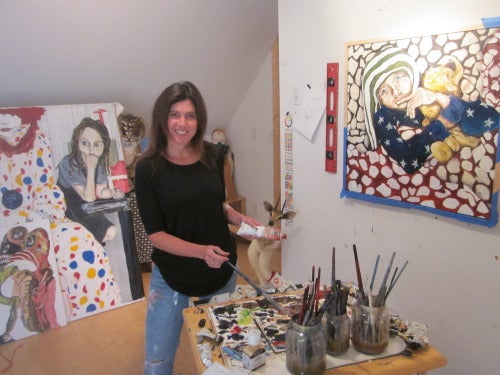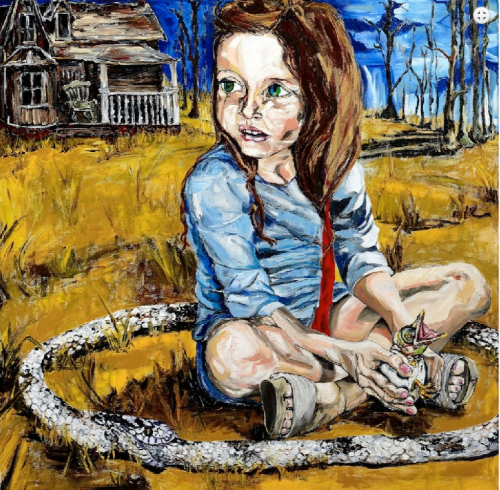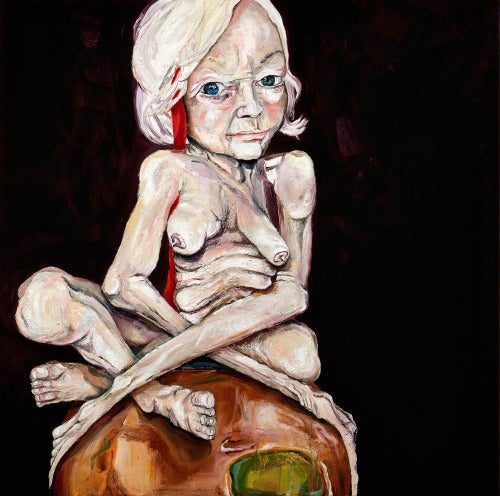
Originally hailing from Miami, painter Carrie Alter earned a BA from the University of Tampa, a BFA from the Ringling School of Art and Design in Sarasota, and an MFA from the University of North Carolina at Chapel Hill, where she still lives. Alter is having a banner year for exhibitions, with work in four group shows that opened in September, three of them in New York, as well as others in California, North Carolina, Nashville, Portland, and Peoria, Illinois.
Alter’s oil on canvas paintings glow with taut, technicolor vibrancy, conjuring an alternative reality where unsettling characters greet us. Hybrid deer-ladies in tall stockings, elderly nude women with searing gazes and unapologetic folds of flesh, and round-cheeked toddlers with rabid dogs are among her cast of characters. She lays the paint with various thicknesses, often using an impasto texture for the figures and sharp highlights that conjure an effect of acid brightness and sculptural plasticity.
I caught up with her to talk about this moment in her career and what led her here.
Shana Dumont Garr: Your work is been receiving lots of attention lately, including in some exhibitions out of state. What do you think people are responding to?
Carrie Alter: I’m not sure exactly, but I started applying for shows, memberships, and grants based on the jurors, not just the theme. After seeing my work in juried events, two curators called me with exhibition opportunities. Most recently, New York-based curator Vida Sabbaghi has invited me to participate in a group show at Skylight Gallery in Chelsea.

SDG: Which of your works are included?
CA: Paintings from an earlier series They Bite Because They Are Alive. It’s my reaction to motherhood, the primal feelings I have as I watch my young sons and other family members grow up mixed with my own memories of youth.
SDG: When I first saw your paintings, I was attracted to a type of honesty that I discerned within them. I think it’s a blend between realism and psychological honesty. Could you speak to that?

CA: I’m always telling my students to stop comparing themselves to each other; instead, I ask them to work on bettering what comes out naturally, while learning the foundations of drawing. Teaching and studying art history has helped me see the importance of being honest with my own mark. I love recognizing the creator of a painting I have never seen before based only on the marks, palette, or style. I believe that the more honest the artist is, the more cohesive all their work is.
I have said in the past that it would be disingenuous of me to try to tame or domesticate my work, and that is truer now than ever. If nothing else, I paint from a sincere place, so I see my body of work, even different series, as somewhat cohesive.

oil on canvas, 30 by 24 inches.
SDG: Your paint treatment and the elastic quality of the figures remind me of claymation. Would you say this is part of how you’re blending your own vision of the world with reality?
CA: There is definitely a sculptural aspect to my paintings, in that there is a visible topography in the sheer amount of oil paint I use. I have always created cardboard sculptures as studies for my paintings, and I try to be playful with my imagery since my concepts are so dark.
The sensibility and philosophy of Tim Burton turns me on; I’m sure that comes through in my work somehow. The living creatures I represent on the canvas (human, animal, sometimes combined…), generally have distorted or oversized features, which could be characterized as Rydenesque or anime-like. So I can definitely see the connection.
Also, my undergraduate training at Ringling School of Art may have something to do with my style. They are known for their animation department, a field that many of my friends who I went to school with are working in.

oil on canvas, 30 by 30 inches.
SDG: What are you currently working on?
CA: I am working on four new series of paintings at once: Sleep Marks, which are painting studies of my sleeping sons, where I explore innocence of youth; my Deer Diary paintings and sculptures are more macabre and absurd, blending deer (I collect taxidermy) and human forms; in A Woman of a Certain Age, I depict beauty in aging; and most recently, there’s How I Quit Smoking … the second time.
SDG: Have you always worked on multiple series at once?
CA: I don’t always share this, but my life changed about six years ago. I was given a death sentence from a rheumatologist: I was diagnosed with mixed connective tissue disease (MCTD), a rheumatic-based disorder. I didn’t start truly conceptualizing my work until the diagnosis. Having something to say, layered with my passion for the pure process of painting, has given me a voice that I want to share. At the time I was diagnosed, the average survivor’s life span was 10 years. But I’m a fighter. Muhammad Ali was at my birth and was the third person to hold me.
SDG: Hold up! Muhammad Ali?
CA: Yeah, my father was a boxer and they were friends.

oil on canvas, 48 by 24 inches.
SDG: How did you fight the diagnosis?
CA: My husband and I did some research, and I decided not to take the drugs they prescribed for my condition. I changed my lifestyle, my diet, the way I paint, and within a few months, I regained my strength. I no longer believe I have a “death sentence.”
SDG: How did the way you paint come into play?
CA: Artists throughout history have died young of these lupus types of diseases. They’ve only been studied since the 1970s. I’ve been making and documenting connections between chemical use and blood chemistry in the hopes of one day publishing something on the subject to educate young artists about how to be safer in the studio, as I was not (my hands were often in contact with mineral spirits and turpentine).
I have since changed my way of painting and have rid my studio of solvents. I now mix my oils with safflower oil, linseed oil, and sometimes play with walnut and poppy seed oils. The only chemical I miss is damar varnish.
SDG: I’m so glad that you’ve found a way to keep your painterly style going. The series that first brought my attention to your work is A Woman of a Certain Age, where the women’s skin looks a bit like ominously melting frosting.
CA: The series celebrates the dissolution of the womanly form in a youth-obsessed society—think Alice Neel’s A Self-Portrait, aged 80. I interview each subject while I paint her and record her answers. I hope to, with time, create a multimedia installation with the paintings and the audio of each woman speaking, which will aim at broadening the definition of beauty.
SDG: But I wonder, especially because some of those paintings exaggerate the dissolution part (such as the elongated breasts) rather than widening what we see as beauty, is it instead enabling us to see and accept the passage of beauty?
CA: I think American media has warped our perception of beauty. Women of a certain age become almost invisible but, for example, I’ve always thought of my grandmothers as beautiful.
SDG: Perhaps what we ultimately fear is a loss of control.
CA: Yes, but I believe life experience and knowledge make people more beautiful. Artists don’t naturally see “ugly” in the physical. I look forward to doing my own nude self-portrait when I am a woman of a certain age, exaggerated and distorted to visually elaborate on my own life story.
Shana Dumont Garr is a writer, contemporary art curator, and the director of programs & exhibitions at Artspace in Raleigh, North Carolina.




